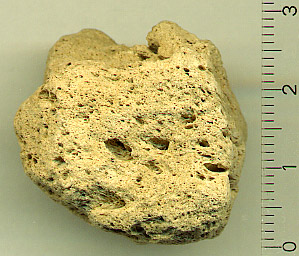In which context did life arise? A problem yet unsolved. Several plausible ideas and hypotheses have been put forward: shallow seas, meteorites (see DNA, Made In Space?), and even much more extreme habitats, such as hydrothermal vents. Perhaps pumice should be added to the list?
Pumice (see figure 1), a volcanic rock formed by solidified frothy lava, is known to be porous and, once upon a time in its history, gas-rich. Now, a new study, published in Astrobiology, poses that extensive rafts of pumice have four properties that would actually make them a suitable candidate for the location where life arose.

Figure 1: An example of pumice.
(Source: Wikimedia Commons, user MPF)
Those “four remarkable properties” are:
- Pumice develops the highest surface-area-to-volume ratio known for any rock type during eruption.
- So far, it’s the only known rock type that floats at the air-water surface and subsequently becomes beached in the tidal zone for extensive periods of time.
- The third property is that it is exposed to a wide variety of conditions, which includes dehydration.
- Lastly, it is a rock type that has the ability to adsorb metals, organics, phosphates and a variety of organic catalysts, including, but not limited to, zeolites (microporous aluminosilicate minerals) and titanium oxides.
These properties should, according to the authors, be enough to warrant further research into pumice as potential cradle of life.
In the words of the authors:
Here, we argue that extensive rafts of glassy, porous, and gas-rich pumice could have had a significant role in the origin of life and provided an important habitat for the earliest communities of microorganisms. … These remarkable properties now deserve to be rigorously explored in the laboratory and the early rock record.
Reference
Brasier, M.D.; Matthewman, R.; McMahon, S. and Wacey, D. (2011). Pumice as a Remarkable Substrate for the Origin of Life. Astrobiology. 11(7), pp. 725 – 735. doi:10.1089/ast.2010.0546.


